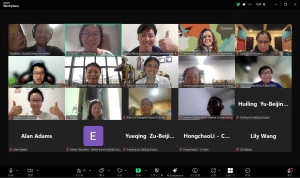Editor’s Note
The author of this article, Liu Jinmei (liujinmei@fonchina.org), works as a General Counsel for Friends of Nature (自然之友), China’s oldest environmental non-profit. The views and opinions expressed in this article are those of the author alone.
To provide some context, it has been possible for environmental organizations in China to initiate public interest litigations ever since the Environmental Protection Law was amended in 2015. There have been a few high-profile cases, such as the “Changzhou poisonous land case”, initiated among others by Friends of Nature, in which the plaintiffs have met with qualified success.
In May 2019, the litigation initiated by Friends of Nature against Hyundai Motor over exhaust pollution, which was reviewed by the Beijing Fourth Intermediate People ’s Court and ended with an agreement to create a charitable trust, was chosen for the ninth edition of “China’s top ten public interest litigations (2019)”1. This case, like the other ones selected, is a public interest litigation that has had a broad impact on society and great legal significance.
The reason for its selection is that the payment, management and use of compensations for environmental damages, which is a component of environmental public interest litigations, has always been difficult to put in practice. Being able to really use the compensation money for environmental restoration, and making sure the funds are used for specific purposes only, is a very important part of making environmental public interest litigations effective. This particular case lasted for several years, and an agreement was finally reached through mediation. The parties concerned agreed to use a charitable trust to manage the compensation funds and effectively use them for environmental restoration, something that has an important value and significance for ensuring the effective use of the compensations and promoting the implementation of environmental public interest litigations.
Just one month ago, the public interest litigation brought about by the China Green Development Association against Taobao and the Shenzhen Sumei Corporation for selling equipment to help the owners of cars cheat on their annual inspections was selected for the fifteenth edition of “China’s top ten influential lawsuits (2019)”. The reason for its selection is that the case helped to further clarify the responsibility for air pollution in the Internet age and expand the scope of environmental public interest litigations. The second instance court of the case clearly pointed out that online stores should strengthen information management and establish an effective supervisory system. This will make it easier to urge online platforms to develop a due sense of responsibility about selling products that may be used for illegal purposes.
Prior to this, on March 20, the “Yunnan Green Peacock Case”, filed by Friends of Nature, also attracted attention as the first preventive public interest litigation for the protection of endangered wildlife in China. The first-instance judgment was delivered by the Kunming Intermediate People’s Court of Yunnan Province: it was determined that the defendant, China Hydropower Consulting Group Xinping Development Co., Ltd., should immediately stop the construction of the Cansa River First-Class Hydropower Station based on the existing environmental impact assessment. After the first-instance judgment was made, many media outlets including Xinhua News Agency and the People’s Daily published or reproduced relevant information about the case.
In July 2019, at the press conference for the fifth anniversary of the establishment of the Supreme People’s Court Environmental Resources Adjudication Division, it was revealed that according to the latest data, since the implementation of the revised Environmental Protection Law in January 2015, People ’s Courts at all levels have ensured that social organisations can raise environmental civil public interest litigations, 298 civil public interest litigations cases filed by social organisations have been accepted in accordance with the law, and 119 cases have reached a conclusion. These numbers are not huge compared with the nearly 4,000 cases filed by procuratorial organs at all levels.
However, as Wei Wenchao, Vice President of the Environmental Resources Adjudication Division, explained in an interview, since the implementation of the new environmental protection law the number of public interest litigation cases filed by social organisations may not have been large, but the cases have been relatively rich in scope, and they have had a lot of influence. The cases mentioned above, all of which attracted the public’s attention, had the media almost falling over each other to report on them, and were even selected in rankings of influential lawsuits, are the best evidence for this.
It is inevitable that there should only be a handful of social organisations that are capable and willing to file public interest litigations. Of course, there are also very few social organisations that choose public interest litigation as their main work strategy. Although there are no precise statistics, the available data suggests that about 30 social organisations have filed more than one public interest litigation in the past five years. As for why there are few social organisations willing to throw themselves into such cases, and the number of cases filed is relatively small, the reasons are quite complicated. They include not only the thresholds and obstacles brought about by the imperfections of the system itself, but also the resistance that the overall development and growth of social organisations encounter in the external environment, as well as the challenges brought about by the organisations’ own limited capabilities and lack of resources, when even the law is calling for public interest litigations to become part of the work method and strategy of social organisations.
As space is limited, this article will not discuss the first two “external” factors, and will mainly focus on what it means for the professional development of social organisations when they choose public interest litigations as one of their main advocacy strategies and professional practices, and what kinds of needs and challenges they may have.
When environmental protection organisations choose to become involved in public interest litigations, the first challenge they must face is the issue of professional competence. When they act as the plaintiff and file a lawsuit themselves, regardless of the final outcome of the case, they inevitably face many risks, including legal and even financial risks. This requires the decision-makers within the organisations to have the ability to identify, control and respond to these risks. At the case level, an external lawyer can be entrusted to follow up and handle the specific legal affairs. But at a few critical junctures, when key decisions need to be made, if the environmental organisation lacks sufficient internal experience and professionals who can analyse and judge the aforementioned risks, they may face many difficulties. A lawyer acting as a representative can make a careful and thorough analysis and state the pros and cons, but an environmental organisation acting as the plaintiff must still measure and control the case as a whole from all levels, and thus make a decision on how to maximise public interest but minimise risks to the organisation. This is often the part that a lawyer cannot handle alone.
Environmental protection organisations may face these challenges at various stages of a case, from case selection to the filing of a lawsuit until the final settlement. For example, a lawyer will analyse the facts of the case and the strength of the evidence from a professional perspective with regards to whether a case is suitable for litigation, but the cost of litigation will probably not be the primary consideration. However an environmental organisation acting as plaintiff has no choice but to consider the costs of litigation, the possible risk of losing the lawsuit and other issues.
When a lawsuit reaches the point of negotiation and mediation, the lawyer will make a recommendation from the perspective of the case itself and from the technical level as to whether a mediation agreement should be reached. But for charitable organisations, for which “credibility” is the most valuable intangible asset, when facing a mediation plan, they must still consider the degree of public acceptance and whether this type of plan can maximise the public interest. Sometimes it is even necessary to find the greatest balance between technical factors, practical constraints and the degree of public approval. Therefore, if an environmental organisation wants to use public interest litigation as one of its long-term strategies, it has no choice but to consider cultivating its own experts to establish its own professional competence. In this sense, public interest litigations will actually force environmental protection organisations to establish and improve their own professional competence.
In addition, environmental protection organisations with very limited resources also need to carefully consider the issue of resource allocation when designing an issue, selecting strategies and getting involved in a case. Unlike some other sectors, issues in the environmental sector are multiple and varied, with many being strongly scientific in nature. Therefore each time environmental organisations choose to become involved in a new sector, they may face completely new knowledge gaps. For example, organisations that have long been concerned with the issue of pollution may not be at all familiar with the issues surrounding biodiversity. Organisations that have always dealt with marine protection may not have any understanding of energy and climate issues. As an environmental organisation, the goal of filing a public interest lawsuit is not limited to pointing out specific problems and resolving a particular case. The wider goals are to send out a warning to a certain industrial sector, point out common problems and even promote the introduction and improvement of laws.
Therefore, whether choosing to file a series of cases of the same type to expose problems in a certain industry, to try cases of different types that are highly representative, or to use individual cases to awaken “dormant clauses” within a certain law, all of these require environmental organisations to conscientiously discuss and carefully evaluate these issues before filing a case. To be able to effectively complete the aforementioned discussion, the team needs to possess an understanding of the current environmental issues, a certain degree of foresight and a minimum understanding of the relevant sector.
In many cases, the capability and resources of environmental organisations themselves may be insufficient to overcome all of the aforementioned challenges. They need to request help from external sources, including experts and scholars from the relevant sectors, or to unite with their counterparts. They may even need to seek cooperation with procuratorial agencies and environmental protection departments. This will also require global organisations to have the power to attract and integrate external resources, while persevering to maintain their own independence at the same time, and also to be able to interact with all parties to achieve positive outcomes.
The challenges and the requirements mentioned above appear to make things extremely difficult. But this is emphatically not to say that environmental organisations must become specialists in every field in order to enter the field of public interest litigation work. A lot of knowledge and experience can be studied and accumulated gradually through a practical process. And the challenges, in their layers upon layers, that are brought up by public interest litigations can also push environmental organisations to mature and evolve, and gradually move in the direction of specialist development.
Looking at the policy documents issued at the highest level, we can see that public interest litigation systems have been mentioned several times as an important system for the modernisation of social governance, and this appears to crystallise their important position.
On 31 October 2019, the Fourth Plenary Session of the 19th CPC Central Committee adopted the “Decision relating to upholding and improving the system of Socialism with Chinese Characteristics and promoting the modernisation of China’s governance system and governance capability”, which proposes targets for supervising the strengthening of the law’s implementation, and defines requirements to expand the scope of public interest litigation cases. Moreover, in upholding and improving the system of ecological civilisation, and advancing the goals for harmony between humans and nature, it defines and proposes a strict system of job responsibility for environmental protection, and improves the concrete requirements for the system of public interest litigations for the protection of the natural environment.
Less than half a year ago, in March 2020, the General Office of the Central Committee of the CPC and the General Office of the State Council published the “Guiding Opinions on Building a Modern Environmental Governance System”. This document proposes that by 2025 the participation of market players and the public should be encouraged, and an environmental governance system with effective stimulation, diversified participants and sound interactions should be created. Furthermore, it defines a system for the whole public to take part in a sound environmental governance system, and intensifies targets for social supervision. The “Guiding Opinions” defines the requirements and increase the strength of litigations against acts that destroy the ecology and the environment, and it reinforces the work of the inspection organs in bringing about such litigations. At the same time, it requires qualified environmental organisations to be “guided” in accordance with the law, to carry out environmental public interest litigations. While they use the terms “increase” and “strengthen” for public interest litigations, in the case of the requirements for environmental organisations the terms “guidance” and “support” are used. This is probably significant and leaves food for thought.
With the opportunity afforded by these new policies, how should environmental organisations across China genuinely participate any way they can in the process of constructing a modern environmental governance system, and while upholding the precondition of their own independence, interact soundly with the other parties involved in environmental governance? Public interest litigations are of course not the only path. But while the other parties are unceasingly promoting their own governance capabilities, even if some environmental organisations do not choose public interest litigations as their strategy, does this signify that these organisations do not need to face the challenges of specialisation? Facing this proposition of constructing a modern environmental governance system, how will environmental organisations prove their own strategies’s effectiveness and social value? Perhaps it is worth it for environmental organisations to reflect upon and investigate these questions thoroughly.
Of course, all these challenges cannot be resolved by environmental organisations on their own, especially in the long-term. Impact litigations are an expensive strategy, and they can attract extensive public attention and have a remarkable social impact, to the extent that they can even promote far-reaching changes to policy and laws. But it is in the nature of this strategy that it is destined not to have as instant an effect as other kinds of work, or immediately produce results. Even if there are results, it is a strategy that needs long-term persistence and investment, so much so that it comes with risks. Therefore, it needs to be accompanied by the attention and patience of specialised and passionate funders, and requires the understanding and support of the public. Only with the firm support and cooperation of the funders can more environmental organisations persist in specialising and have the courage to continue exploring.
As discussed above, the external environment is indeed important, but the core factor that decides how far an environmental organisation can go down the road of public interest litigations is still the issue of specialisation. This means not merely the specialisation of organisations’ strategies and professional capabilities, but specialisation in the collection of resources, the creation of networks and the creation of human talent. It sounds like there are many difficulties, but if we hope that our eyes can see the stars and our feet can touch the sea, then we must use sharper minds to help teams and organisations see further into the future, and at the same time use specialist capabilities to guide teams and organisations to fight battle after battle, and finally grow to become social organisations that cherish their missions unswervingly but know how to make use of their advantages to gain respect from all sides.
[1] Jointly published by the Case Law Research Center of the China Legal Scholars Association, the Research College on Litigation Law of the China University of Political Sciences and Law, the Supreme People’s Court and Legal Weekly.



